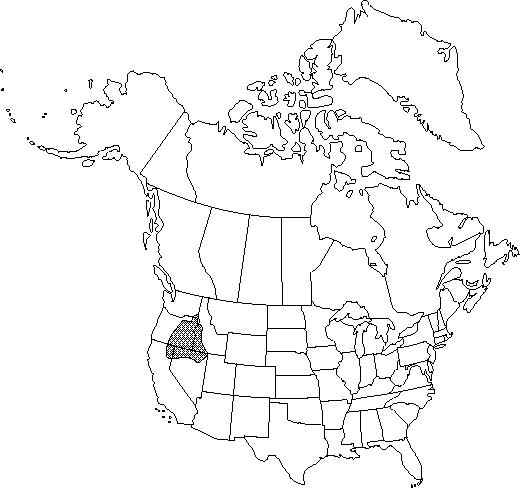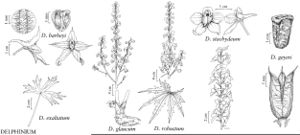Delphinium stachydeum
Proc. Biol. Soc. Wash. 27: 61. 1914.
Stems (40-)70-150(-200) cm; base reddish, puberulent. Leaves mostly on proximal 1/2 stem; basal leaves absent at anthesis; cauline leaves 8-16 at anthesis; petiole 0.5-17 cm. Leaf blade light green, ± round, 2-8 × 3.5-11 cm, sparsely pubescent; ultimate lobes 7-19, width 1-8 mm, apex tapering to point; veins obscure. Inflorescences (14-)30-60(-102)-flowered, dense, cylindric; pedicel spreading, 0.8-2(-3) cm, puberulent; bracteoles 1-4 mm from flowers, green, linear, 2-7(-10) mm, puberulent. Flowers: sepals bright blue, puberulent, lateral sepals spreading, 9-13 × 4-7 mm, spurs straight, within 30° above or below horizontal, 11-17 mm; lower petal blades ± covering stamens, 4-8 mm, clefts 0.5-2 mm; hairs sparse, centered, mostly near junction of blade and claw above base of cleft, white. Fruits 10-15 mm, 3.5-4.5 times longer than wide, puberulent. Seeds wing-margined; seed coat cells with margins straight, surfaces ± roughened.
Phenology: Flowering summer.
Habitat: Swales in Artemisia scrub
Elevation: 1300-3000 m
Distribution

Calif., Idaho, Nev., Oreg., Wash.
Discussion
Populations of Delphinium stachydeum are widely scattered in isolated mountain ranges surrounded by desert or grassland. The species has been reported (visual sightings) from northwestern Utah; no specimens have been seen from there. Hybrids between D. stachydeum and D. glaucum have been reported. Although D. stachydeum has been seen flowering within 30 m of flowering D. depauperatum, no hybrids have been observed.
Delphinium stachydeum may possibly be confused with D. geyeri, from which it may be distinguished by its usually greater plant size, less pubescent foliage, and later flowering date. Delphinium stachydeum also may be confused with D. glaucum; see discussion under that species.
Selected References
None.
